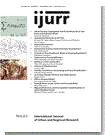Segregation has been one of the most persistent features of urban life and, accordingly, one of the main subjects of enquiry in urban studies. Stemming from a tradition that can be traced back to the Chicago School in the early twentieth century, social segregation has been seen as the natural consequence of the social division of space. Such naturalized understanding of segregation as ‘territorial segregation’ takes space as a surrogate for social distance. We propose a shift in the focus from the static segregation of places—where social distance is assumed rather than fully explained—to how social segregation is reproduced through embodied urban trajectories. We aim to accomplish this by exploring the spatial behaviour of different social groups as networks of movement that constitute opportunities for co-presence. This alternative view recasts the original idea of segregation as ‘restrictions on interaction’ by concentrating on the spatiality of segregation potentially active in the circumstances of social contact and encounters in the city. This approach to segregation as a subtle process that operates ultimately through trajectories of the body is illustrated by an empirical study in a Brazilian city.
Details
Written by:
Vinicius M. Netto , Maíra Soares Pinheiro and Roberto Paschoalino
Digital Object Identifier (DOI)
10.1111/1468-2427.12346
About DOI

